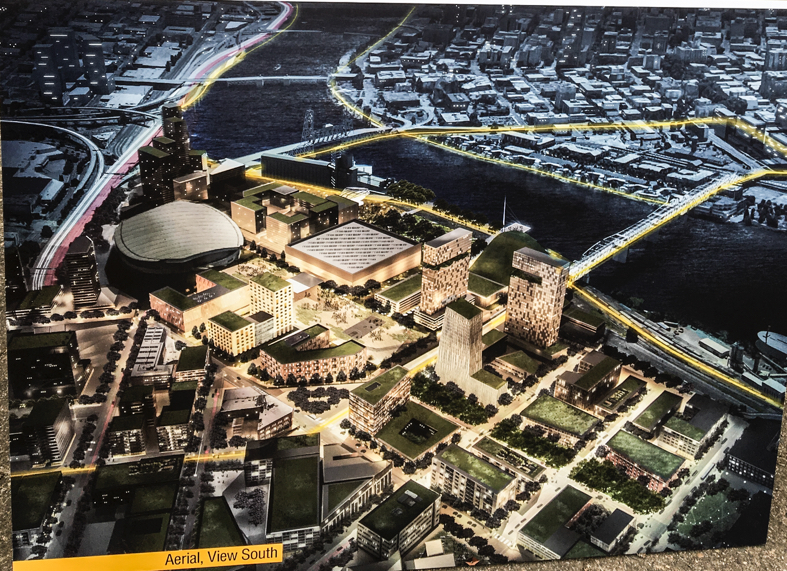
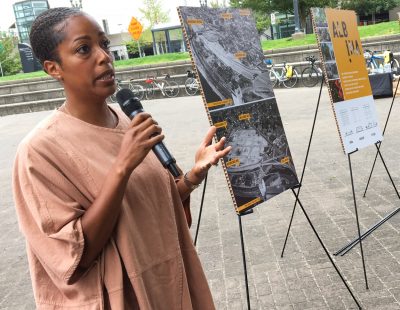
(Photo: J. Maus/BikePortland)
In the early 1950s, the Rose Quarter was a neighborhood of homes, churches and stores. It was a thriving part of our city where many people lived and worked. But by 1958 all the houses were razed to make way for the Memorial Coliseum and eventually the Moda Center. Within the same decade hundreds more homes would see the same fate as city planners gave Legacy Emanuel Hospital and Interstate 5 priority over housing and businesses. These “urban renewal” projects in the Albina corridor had a devastating impact to the community and many of the scars — on human lives and infrastructure — remain unhealed.
A bold new plan unveiled for the first time on Friday seeks to restore that neighborhood — and ideally, the community that went along with it. The “Albina Vision” would develop the 30-acre Rose Quarter with housing and businesses that respects history and embraces the future.
On Friday two of the project’s main backers — Rukaiyah Adams, chief investment officer with the Meyer Memorial Trust and Zari Santner, a former Portland Parks Bureau director — laid out their vision to a crowd of about 70 electeds, planners, advocates and government staffers during a stop on the annual Policymakers Ride.
“What we envision is… putting bikes and walkers first and not just having them be unsafe crossing giant highways and streets.”
— Rukaiyah Adams
Adams shared that her great-grandmother moved to the Rose Quarter after fleeing the violence of the Jim Crow south. “It was a lot like Ladds [neighborhood] today,” she said. “Imagine bulldozing Ladds Addition to build a soccer stadium.”
Standing in front of poster boards, Adams (a powerful and respected civic leader who also chairs the Oregon Investment Council) said the current Rose Quarter is an example of the “primacy of the car” and that she wants to, “rebuild a community, not just the physical spaces” of a neighbohood that she refers to as “ground zero for the discussion about equity and history in Portland.”
Adams said the group behind the vision (which according to the Willamette Week also includes Moda Health Executive Vice President Steve Wynne) has been meeting for a year. Their vision is to keep the Memorial Coliseum and Moda Center and build new buildings and streets around them. The Coliseum — and redevelopment of the Rose Quarter — has been the subject of intense debate and controversy over the years. The “Albina Vision” wouldn’t seek to demolish the Coliseum. Rather, Adams says, Portland must, “Be honest about the destruction of this neighborhood, not back away from that history.”
“The way we see it,” she continued, “the homes of black veterans were bulldozed to builld a monument mostly to white veterans — so this is our Robert E. Lee monument. We look at it and can appreciate the beauty and wanting to protect the architecture; but also feel like there’s a story about what we’re monumenting here that has to be told if it will be preserved.”
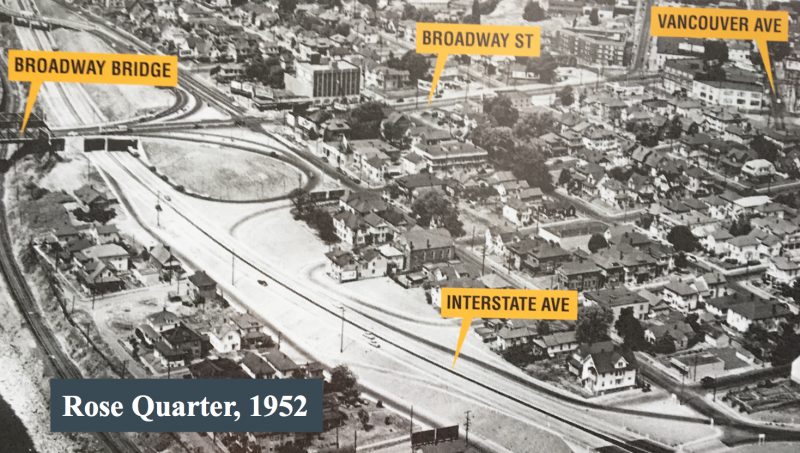
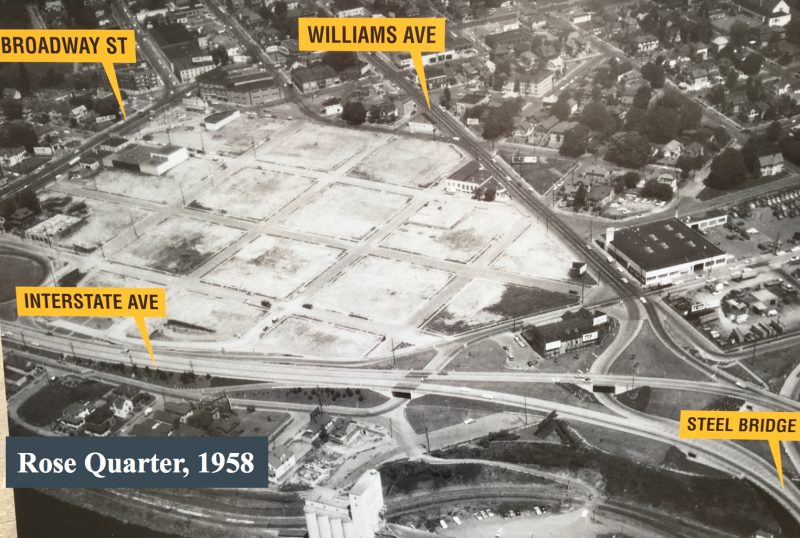


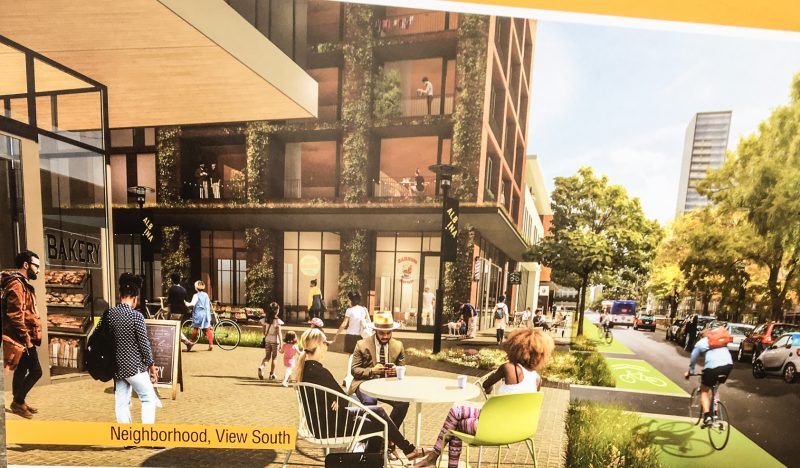
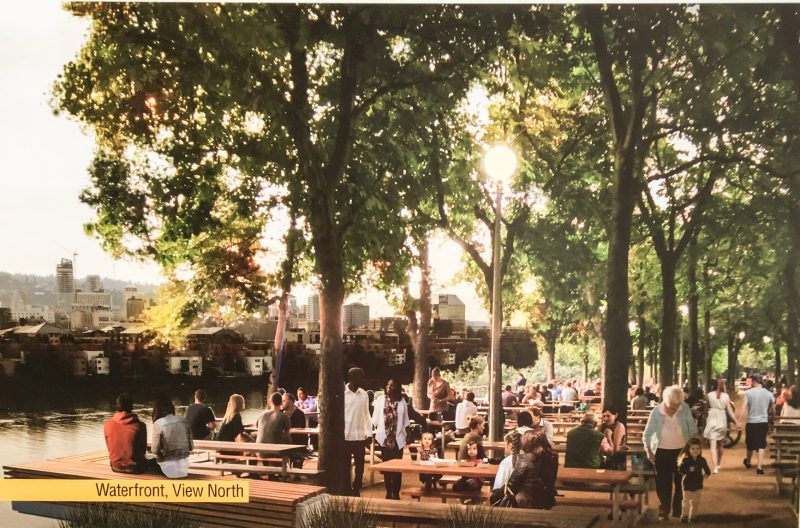
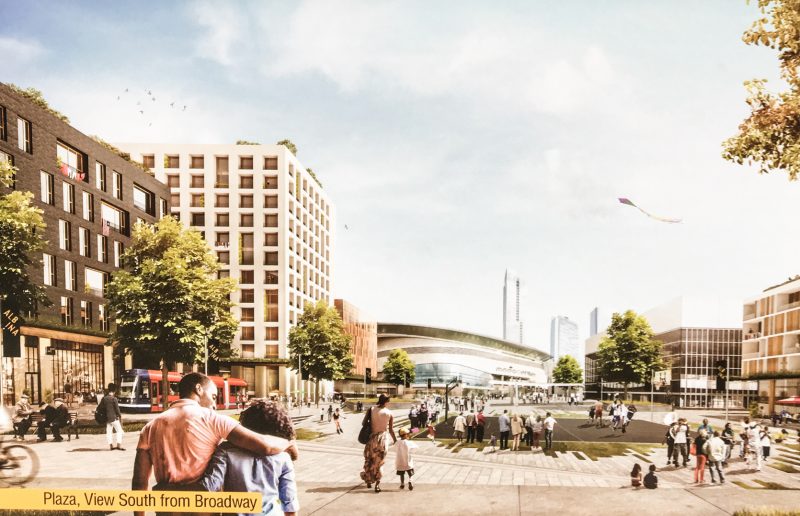

Advertisement
Beyond simply a development project with buildings and plazas, Adams and Santner understand the key mobility issues in the Rose Quarter. Adams spoke of restoring the street grid that used to exist in the 1950s. She then referred to the current conditions as a “system of giant buildings not accessible at the pedestrian level.” “What we envision,” she continued. “Is some combination of both and putting bikes and walkers first and not just having them be unsafe crossing giant highways and streets.”
Santner explained that the most important element of their plan is to bury the existing auto parking along Broadway. “Broadway was historically the central spine of this area and by constructing these parking garagaes, this area was totally severed visually and physically from Broadway,” she said. “The idea is to remove these parking garages and allow parking underneath these plazas so the Moda Center and Coliseum are connected to Broadway and to the neighborhood that would be built beyond it.”


Santner also addressed the “controversial” ODOT/PBOT project to widen I-5. “We don’t really care whether the freeway is going to expand or not. That’s not the issue,” she said. “What we care about is, if the freeway is there and it’s not removed, it needs to have a lid.”
Their plans call for a lid over the freeway from Clackamas Street (two blocks north of Multnomah) to beyond Broadway. And instead of just parks and trees like ODOT is proposing for the much smaller lids in the I-5 Rose Quarter project, Santner said they want to put buildings and streets above the freeway.
Another feature of the plan is a lid that would extend from the Memorial Coliseum over Interstate Avenue and the railroad tracks along the Willametter River (see images) in order to provide public river access to an area that is now industrial and inaccessible between the Steel and Broadway bridges. The project would, in Adams’ words, “Allow the connection to the river to be healed,” and “Give the river back to the people.”
“Our intent is to stitch back this area to the area to the east, Lloyd Center, and the north,” Santner said.
Right now the group behind Albina Vision sees themselves simply as curators and stewards. They say they want more partners and are in the process of forming a nonprofit. Asked if there was a group or project they modeled themselves after, Santner said I should compare them to Friends of the High Line in New York City. “They were just a friends group too at first,”she said. “But because the vision was so great and because it was embraced by the city, money rolled in and that’s what we want to do.”
Reminder: Tomorrow night (Tuesday, 9/12) is the first open house for the I-5 Rose Quarter project. Check the project website and plan to stop in Dishman Community Center between 5:00 and 7:00 if you can.
— Jonathan Maus: (503) 706-8804, @jonathan_maus on Twitter and jonathan@bikeportland.org
Never miss a story. Sign-up for the daily BP Headlines email.
BikePortland needs your support.

